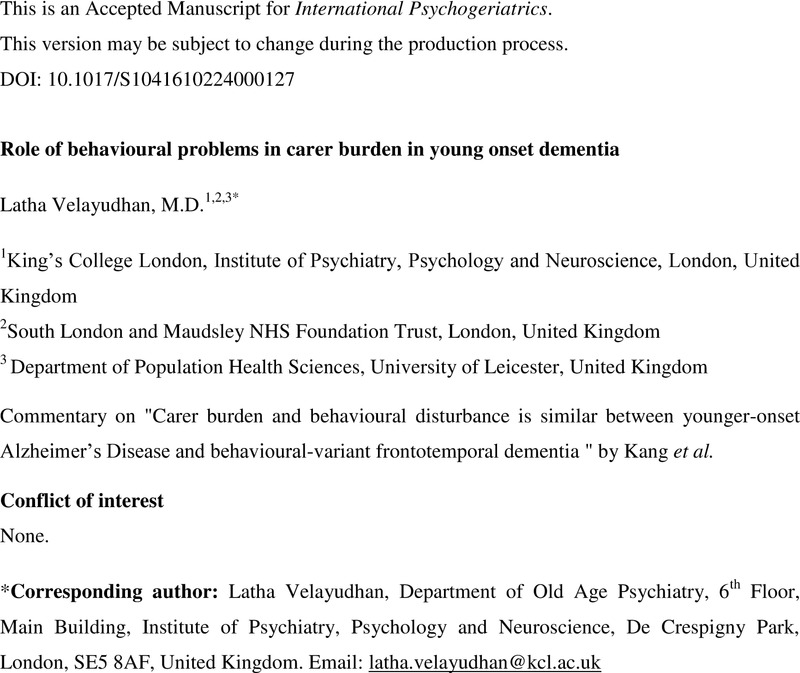No CrossRef data available.
Article contents
Role of behavioral problems in carer burden in young-onset dementia
Commentary on “Carer burden and behavioural disturbance is similar between younger-onset Alzheimer’s Disease and behavioural-variant frontotemporal dementia” by Kang et al.
Published online by Cambridge University Press: 22 January 2024
Abstract
An abstract is not available for this content so a preview has been provided. Please use the Get access link above for information on how to access this content.

- Type
- Commentary
- Information
- Copyright
- © The Author(s), 2024. Published by Cambridge University Press on behalf of International Psychogeriatric Association
References
Bédard, M., Molloy, D. W., Squire, L., Dubois, S., Lever, J. A., & O'Donnell, M. (2001). The Zarit Burden interview: a new short version and screening version. Gerontologist, 41(5), 652–657.Google Scholar
Campbell, P., Wright, J., Oyebode, J., Job, D., Crome, P., Bentham, P., Jones, L., & Lendon, C. (2008). Determinants of burden in those who care for someone with dementia. Int J Geriatr Psychiatr, 23(10), 1078–1085.Google Scholar
Chiari, A., Pistoresi, B., Galli, C., Tondelli, M., Vinceti, G., Molinari, M. A., Addabbo, T., & Zamboni, G. (2021). Determinants of caregiver Burden in early-onset dementia. Dement Geriatr Cogn Dis Extra, 11(2), 189–197.Google Scholar
Connors, M. H., Teixeira-Pinto, A., Ames, D., Woodward, M., & Brodaty, H. (2023). Apathy and depression in mild cognitive impairment: distinct longitudinal trajectories and clinical outcomes. International Psychogeriatrics, 35(11), 633–642.Google Scholar
Cullinan, J., Fealy, G., Lafferty, A., O’Shea, E., & Teahan, Á. (2021). An analysis of carer burden among family carers of people with and without dementia in Ireland. International Psychogeriatrics, 33(4), 347–358.Google Scholar
Cummings, J. L., Mega, M., Gray, K., Rosenberg-Thompson, S., Carusi, D. A., & Gornbein, J. (1994). The neuropsychiatric inventory: comprehensive assessment of psychopathology in dementia. Neurology, 44(12), 2308–2314.Google Scholar
Feast, A., Moniz-Cook, E., Stoner, C., Charlesworth, G., & Orrell, M. (2016). A systematic review of the relationship between behavioral and psychological symptoms (BPSD) and caregiver well-being. International Psychogeriatrics, 28(11), 1761–1774.Google Scholar
Folstein, M. F., Folstein, S. E., & McHugh, P. R. (1975). “Mini-Mental state”. A practical method for grading the cognitive state of patients for the clinician. Journal of Psychiatric Research, 12, 189–198.Google Scholar
Kandiah, N., Wang, V., Lin, X., Nyu, M. M., Lim, L., Ng, A., Hameed, S., & Wee, H. L. (2016). Cost related to dementia in the young and the impact of etiological subtype on cost. Journal of Alzheimers Disease, 49(2), 277–285.Google Scholar
Kang, M. J. Y., Farrand, S., Evans, A., Chiu, W.-H., Eratne, D., Kelso, W., Walterfang, M., Velakoulis, D., & Loi, S. M. (2023). Carer burden and behavioral disturbance is similar between younger-onset Alzheimer’s disease and behavioral variant frontotemporal dementia. International Psychogeriatrics, 1–8. https://doi.org/10.1017/S1041610222001259
Google Scholar
Lim, L., Zhang, A., Lim, L., Choong, T.-M., Silva, E., Ng, A., Kandiah, N., & Grill, J. (2018). High caregiver Burden in young onset dementia: what factors need attention? Journal of Alzheimers Disease, 61(2), 537–543.Google Scholar
Liu, S., Liu, J., Wang, X.-D., Shi, Z., Zhou, Y., Li, J., Yu, T., & Ji, Y. (2018). Caregiver burden, sleep quality, depression, and anxiety in dementia caregivers: a comparison of frontotemporal lobar degeneration, dementia with Lewy bodies, and Alzheimer’s disease. International Psychogeriatrics, 30(8), 1131–1138.Google Scholar
Loi, S. M., Eratne, D., Cadwallader, C., & Ravanfar, P. (2021). Investigating the clinical utility of biomarkers and other novel tests in younger onset neurocognitive disorders: the BeYOND study, protocol for a longitudinal clinical study in a real-world setting. Psychiatry and Clinical Psychology, preprint. https://doi.org/10.1101/2021.07.03.21259825
Google Scholar
Mendez, M. F. (2006). The accurate diagnosis of early-onset dementia. Int J Psychiatry Med, 36(4), 401–412.Google Scholar
Mioshi, E., Foxe, D., Leslie, F., Savage, S., Hsieh, S., Miller, L., Hodges, J. R., & Piguet, O. (2013). The impact of dementia severity on caregiver burden in frontotemporal dementia and alzheimer disease. Alzheimer Dis Assoc Disord, 27(1), 68–73.Google Scholar
Rossor, M. N., Fox, N. C., Mummery, C. J., Schott, J. M., & Warren, J. D. (2010). The diagnosis of young-onset dementia. Lancet Neurology, 9(8), 793–806.Google Scholar
Sheikh, F., Ismail, Z., Mortby, M. E., Barber, P., Cieslak, A., Fischer, K., Granger, R., Hogan, D. B., Mackie, A., Maxwell, C. J., Menon, B., Mueller, P., Patry, D., Pearson, D., Quickfall, J., Sajobi, T., Tse, E., Wang, M., Smith, E. E., & for the PROMPT registry investigators (2018). Prevalence of mild behavioral impairment in mild cognitive impairment and subjective cognitive decline, and its association with caregiver Burden. International Psychogeriatrics, 30(2), 233–244.Google Scholar
Sink, K. M., Covinsky, K. E., Barnes, D. E., Newcomer, R. J., & Yaffe, K. (2006). Caregiver characteristics are associated with neuropsychiatric symptoms of dementia. Journal of The American Geriatrics Society, 54(5), 796–803.Google Scholar
van Vliet, D., de Vugt, M. E., Bakker, C., Koopmans, R. T., & Verhey, F. R. (2010). Impact of early onset dementia on caregivers: a review. Int J Geriatr Psychiatry, 25(11), 1091–1100.Google Scholar
Walterfang, M., Siu, R., & Velakoulis, D. (2006). The NUCOG: validity and reliability of a brief cognitive screening tool in neuropsychiatric patients. Aust N Z J Psychiatry, 40(11-12), 995–1002.Google Scholar
Wear, H. J., Wedderburn, C. J., Mioshi, E., Williams-Gray, C. H., Mason, S. L., Barker, R. A., & Hodges, J. R. (2008). The Cambridge Behavioural Inventory revised. Dementia & Neuropsychologia, 2, 102–107. https://doi.org/10.1590/S1980-57642009DN20200005
Google Scholar
Zarit, S. H., Anthony, C. R., & Boutselis, M. (1987). Interventions with care givers of dementia patients: comparison of two approaches. Psychology and Aging, 2(3), 225–232.Google Scholar


